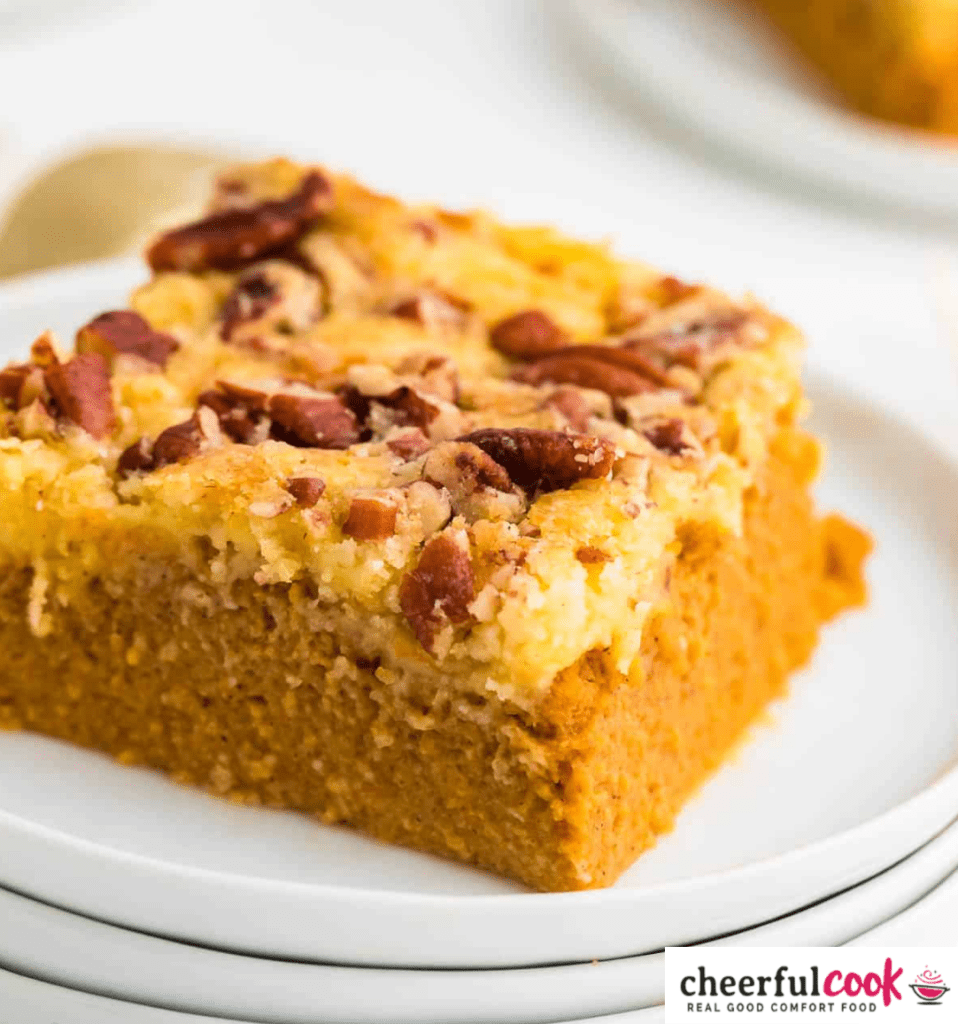How to Grow Pumpkins for Beginners
It’s a favorite of children and adults alike, especially in the fall. Pumpkins. A staple in almost every backyard garden. Today we are going to go over everything you need to know on how to grow pumpkins for beginners.
A great resource to have in your gardening 101 library. Growing big pumpkins that are perfect for carving all begins before the seeds go into the ground and we are going to map out all the steps. From planting to tending, weeding to pest control and beyond.
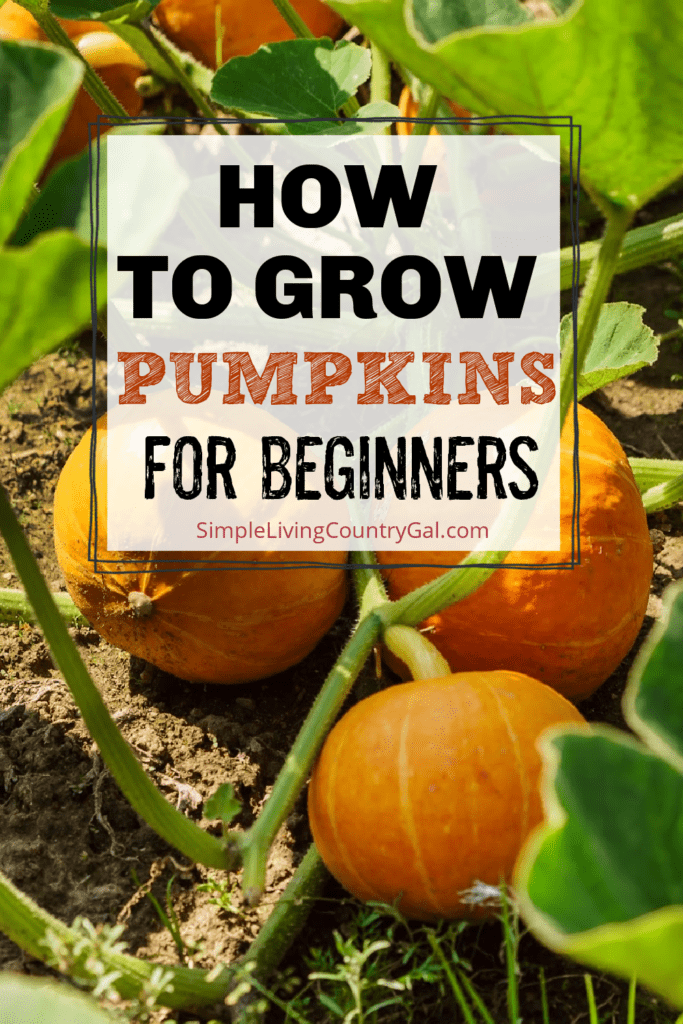
Pumpkins are an American tradition; they’ve been growing in North America for about 5,000 years. In addition to carving them up for Halloween or decorating your front porch for the fall, pumpkins are great for many recipes, from pumpkin bread and pancakes to replacing oil in some of your favorite baked goods for added fiber.
While growing pumpkins is fairly easy even for beginners, they do have a long growing season, and they do require a lot of space to grow. In order to mature, pumpkins need anywhere from 75 to 100 frost-free days. That means you’ll need to plant between late May and early July, depending on where you live, for a fall harvest.
Since pumpkins grow on vines of 20 feet or more, you’ll also need plenty of space for them to spread out.
In my first year of growing pumpkins, I wasn’t quite prepared for how big each plant would get, and my garden quickly resembled a forest of large pumpkin leaves.
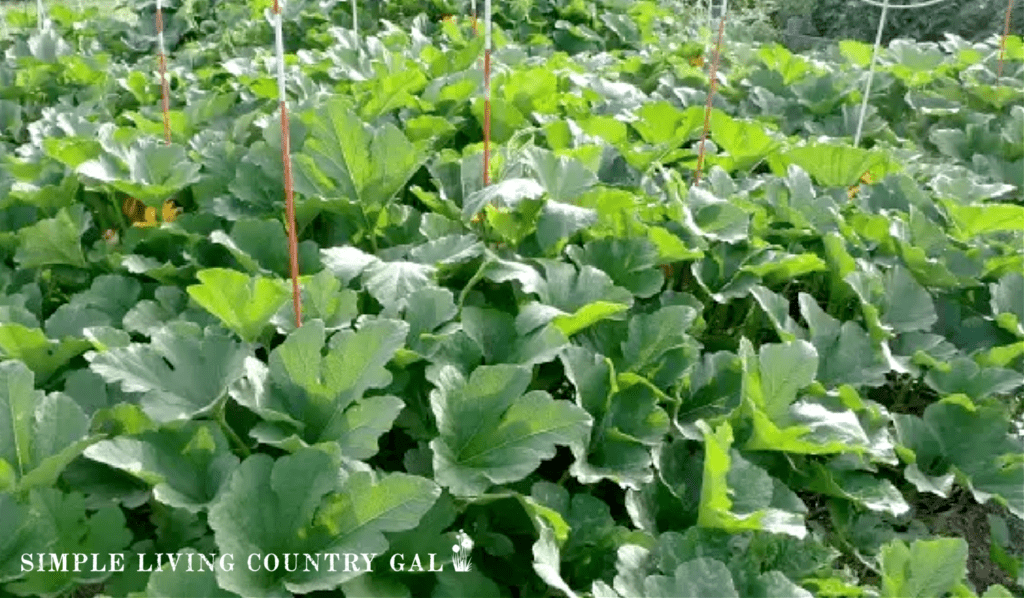
If you have the space, having your own personal pumpkin patch can be a lot of fun for your family. And bonus, it is a great way to make money on the homestead. You can set up a self-serve area with a collection of bright orange pumpkins for folks to buy and take to their homes for the holidays.
What You Need to Grow Pumpkins
In order for pumpkins to completely mature and grow to their full size, you’ll need to do some pre-planning before you begin.
Seeds or Seedlings
Pumpkins can be grown from seedlings you started indoors, but I have found they grow best when the seeds are planted directly in the ground.
Soil Temperature
You will want the soil temperature to be at least 70° before planting, but soil temps of 95° is optimal. Pumpkins really like warm soil and are very sensitive to cold.
To ensure the right conditions for planting, you can check the soil’s temperature with a garden soil thermometer.
Enough Sun
You’ll want to find a spot that gets a lot of sunshine most of the day. Pumpkins need at least six hours of direct sunlight but closer to eight hours each day is better.
Space
Pumpkins grow on vines along the ground and need a lot of room to spread out, about 50 to 100 square feet per hill. To save space, you can also plant pumpkins around the edge of your garden and direct the vine growth away from your lawn or walkway. The vines should only be a problem for a few weeks until they slow down and put their energy into producing fruit.
If you prefer, you can grow pumpkins in 5 to 10-gallon growing containers or plant miniature varieties that require less space to grow.
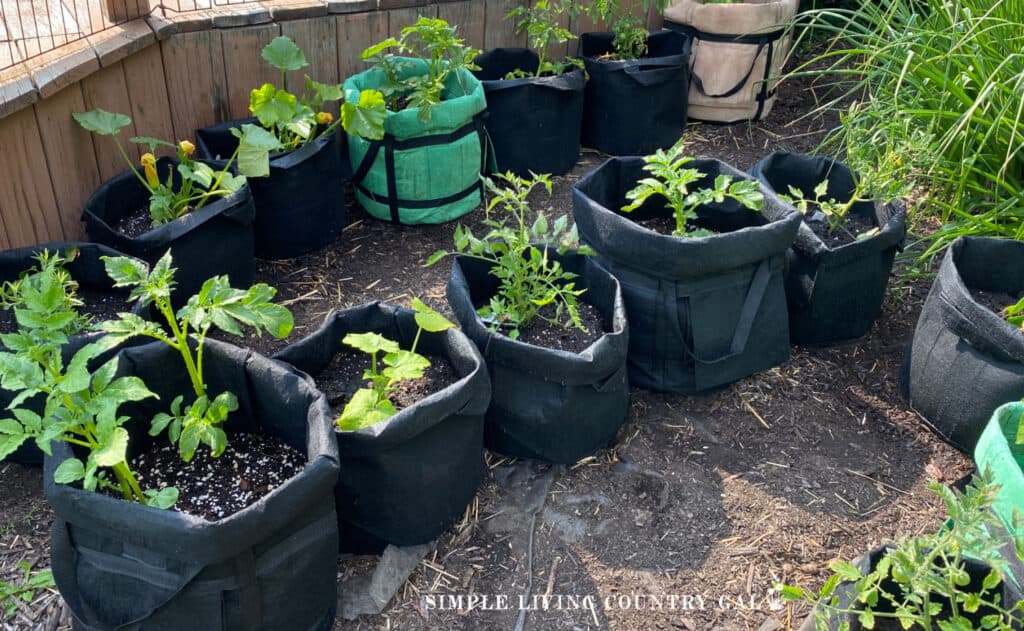
Soil
Pumpkins need to be fed with very nutrient-rich soil that is well-draining so that the roots and vines don’t get soggy, causing rot. For the best soil, mix in a lot of compost and/or aged manure before sowing your seeds into the ground.
How to Grow Pumpkins – an Overview
Pumpkins need to be planted in warm soil and will take about three months to grow. The spring is a great time to prepare your soil, so it is the best environment for your seeds to grow and flourish.
When finalizing the location of your pumpkin patch, remember these points.
- Be sure there is plenty of room for the vines to spread and grow.
- Be sure there is lots of sunshine throughout the day.
- Be sure it is an area where there is good drainage.
If space is limited, you can opt to plant smaller pumpkin varieties inside grow bags or other containers that you can move around if the vines become an issue.
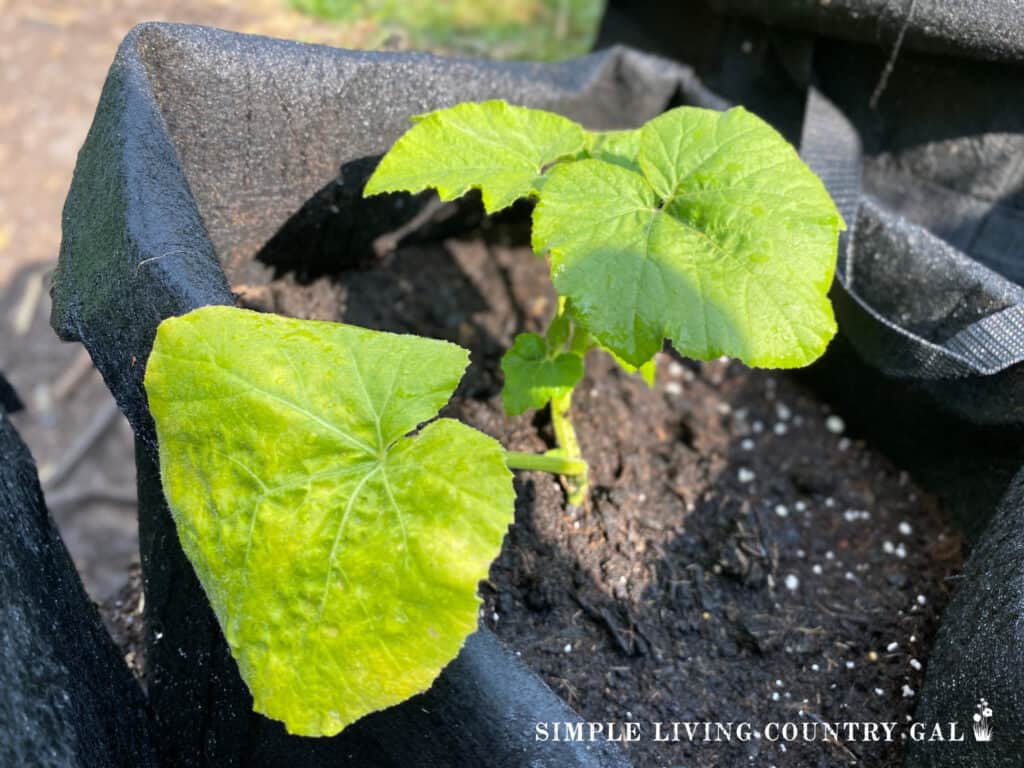
When to Plant Pumpkins
The best time to plant pumpkin seeds is between late May and early July when the soil is warm enough for growth. This will give them plenty of time to mature for a fall harvest, and it will allow the ground time to warm up. If you have any cold snaps once when the plants are young you can cover them for protection so you don’t risk the growth of the plant itself. Row covers, or row blankets are a great way to quickly cover and protect plants.
How to Plant Pumpkins
Seeds should be planted in rows or mounds, also called “pumpkin hills.” Hills will help with drainage while growing and using hills will also help the soil warm up faster, allowing the seeds to germinate more quickly.
Adding nutrients to the soil where you are going to grow your pumpkins is a great way to ensure you have the best environment for growing. Chicken manure is a great fertilizer for a garden. Add a few shovels into the growing area and work it into the soil, about 12-15 inches deep.
If you don’t have manure, you can loosen the soil and mix in about 4 inches of compost.
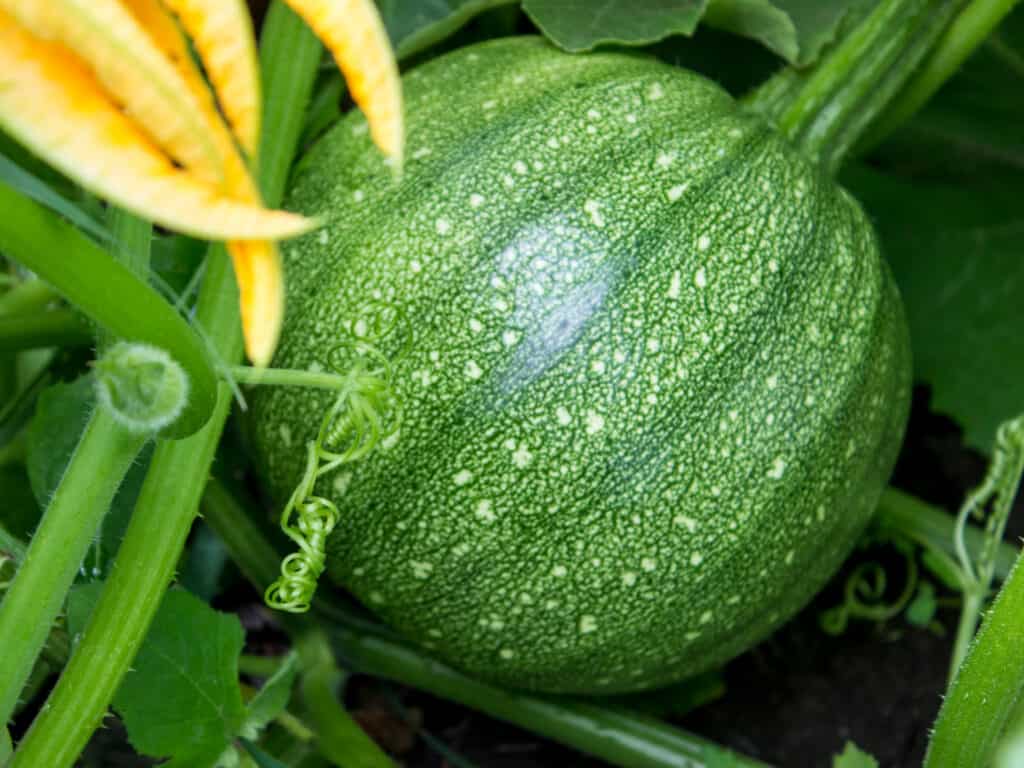
Planting in Hills
When the soil is at the right temperature, use a rake to make a series of hills about 4 to 8 inches apart. In each hill, plant 4-5 seeds 1 inch deep. Cover seeds with soil and water.
The plants should start germinating in less than a week and begin to emerge in about 5 to 10 days. Once the plants are 2 to 3 inches tall, thin them out to 2 to 3 plants per hill by snipping off the unwanted plants at ground level. Do not pull them out of the ground as this could damage the roots of the remaining plants.
Planting in Rows
If you’re planting in rows instead of hills, sow the seeds 6 to 12 inches apart in rows that are 6 to 10 feet apart. Once they emerge and are 2 to 3 inches in height, thin them out to one plant per every 18 to 36 inches, snipping them at ground level.
How Many Pumpkin seeds to Plant
A standard vine will yield about 2-3 pumpkins per plant for larger pumpkins and 3-5 pumpkins per plant for smaller ones.
How Long Do Pumpkins Take to Grow?
Pumpkins can take anywhere from 75 to 100 days to fully mature and be ready to harvest. For a fall harvest, you’ll want to plant in late spring to early summer to make sure there’s plenty of time, plenty of sunlight, and plenty of warm weather.
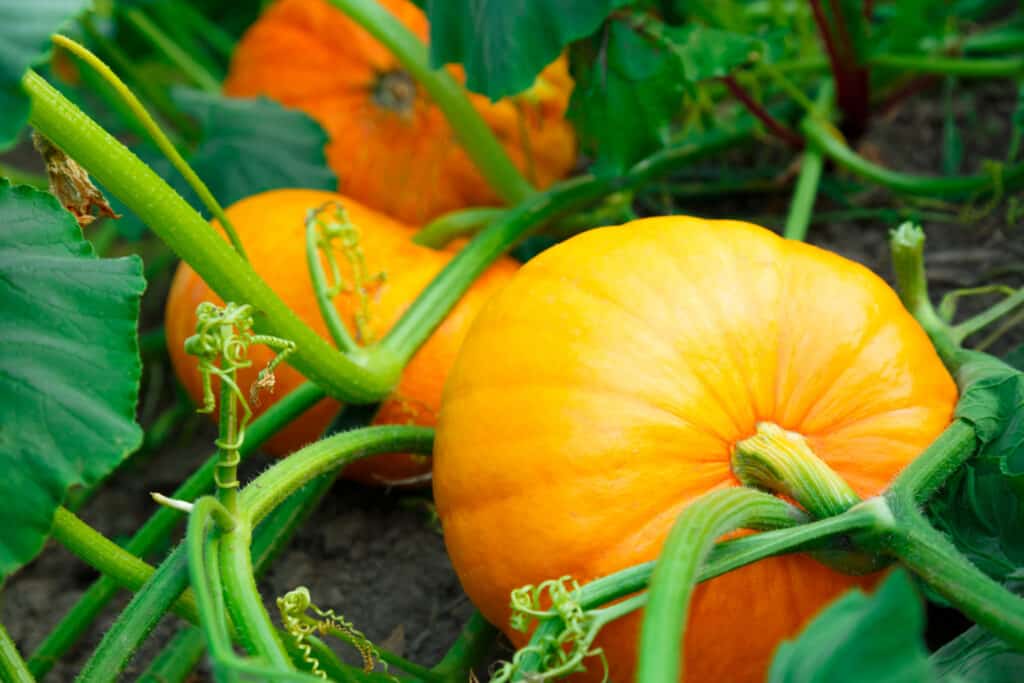
Conditions for growing
Let’s go over again the different conditions you will want to have to grow big bold pumpkins for carving.
Temperature
While we tend to associate pumpkins with cooler weather, they grow best in warm temperatures. The soil should be at least 70° when planting, and pumpkins will do well in soil temperatures of up to about 95°. Summer is the best season for growing pumpkins to give them all the warmth and sunlight they need.
Sun
Pumpkins love direct sunlight. The leaves convert sunlight into internal plant food that travels through the vines to feed the pumpkins. The more sun they get, the bigger your pumpkins will be and the more you’ll have to harvest come fall. Pumpkins should get a minimum of 6 hours of direct sunlight each day, but more is better if you have a sunny spot in your garden.
Soil
The soil will need to be nutrient-rich and well-draining. Adding compost or manure to your soil will help to give the pumpkins plenty of nutrients to grow big and plentiful. Make sure that water can drain away in the soil and that it doesn’t get soggy. This can cause root rot and damage your pumpkins or keep them from growing.
Water
Pumpkin plants require a lot of water, about 1” per week. It’s best to water less but more frequently than to water all at once. This will allow the soil plenty of time to absorb moisture without becoming over-saturated.
GREEN MOUNT Watering Wand, 24 Inches Sprayer Wand with Superior Stainless Head, Perfect for Hanging Baskets, Plants, Flowers, Shrubs, Garden and Lawn




Keep the soil evenly moist, not soggy, and you’ll need to keep the water off the leaves. This means no overhead watering with a sprinkler or hose. Instead, use a hose fitted with a misting nozzle to lightly water the mounds.
You can also install a garden irrigation or a soaker hose to help put watering your plants on autopilot.
Fertilizing
Pumpkins are heavy feeders, so you’ll need to add compost or manure to the soil before planting, as well as fertilizing regularly. You can do this by adding manure or compost mixed with water to sustain the growth and using a high nitrogen formula fertilizer or blood meal in the early growth stage.
When plants are about a foot tall and before the vines begin to run, switch over to a high phosphorus fertilizer like this pumpkin juice.
Wallace Organic Wonder, Soil and Plant Booster


Mulch
Adding mulch around the base of your plants will help with weeds as well as help to control pests. You can use fresh-cut grass, newspaper/cardboard, mulched leaves, or straw. Wait to add mulch once the plants emerge so you can add mulch without covering young seedlings.
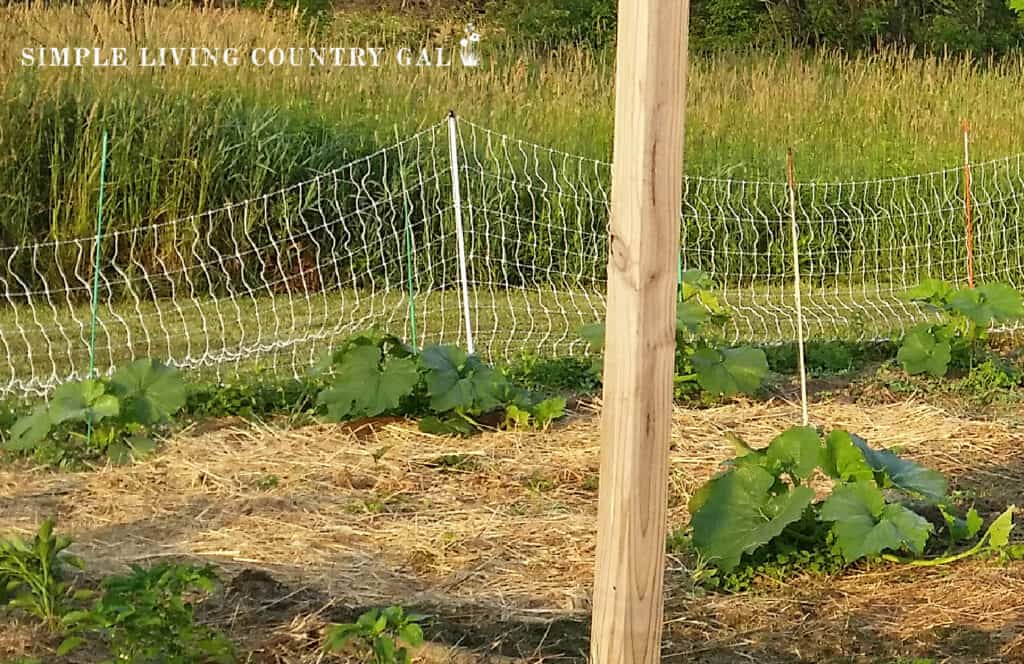
Growing Tips for Pumpkins
· Row covers will help to protect the plants early in the growing season and also help to prevent insect problems. Be sure to remove the cover before flowering, though, so that they can be pollinated by insects.
· When watering, water the hills, being careful not to get the leaves wet. The soil should be moist up to about an inch deep but not soggy. Too much water will cause rot and disease.
· Adding mulch around your pumpkins will help to keep the soil moist, suppress weeds, and discourage pests.
· The root system is very fragile, so be careful not to over-cultivate. Control weeds with mulch or snip at ground level; don’t pull them or you could damage the pumpkin’s roots.
· Many small varieties can be trained to grow up a trellis for space-saving planting.
· If your first flowers don’t form fruits, be patient. Both male and female flowers need to open for pollinating. Bees are essential to pollination, so be mindful when using insecticides to kill pests. If you need to apply them, do so in the late afternoon or evening when the blossoms close for the day.
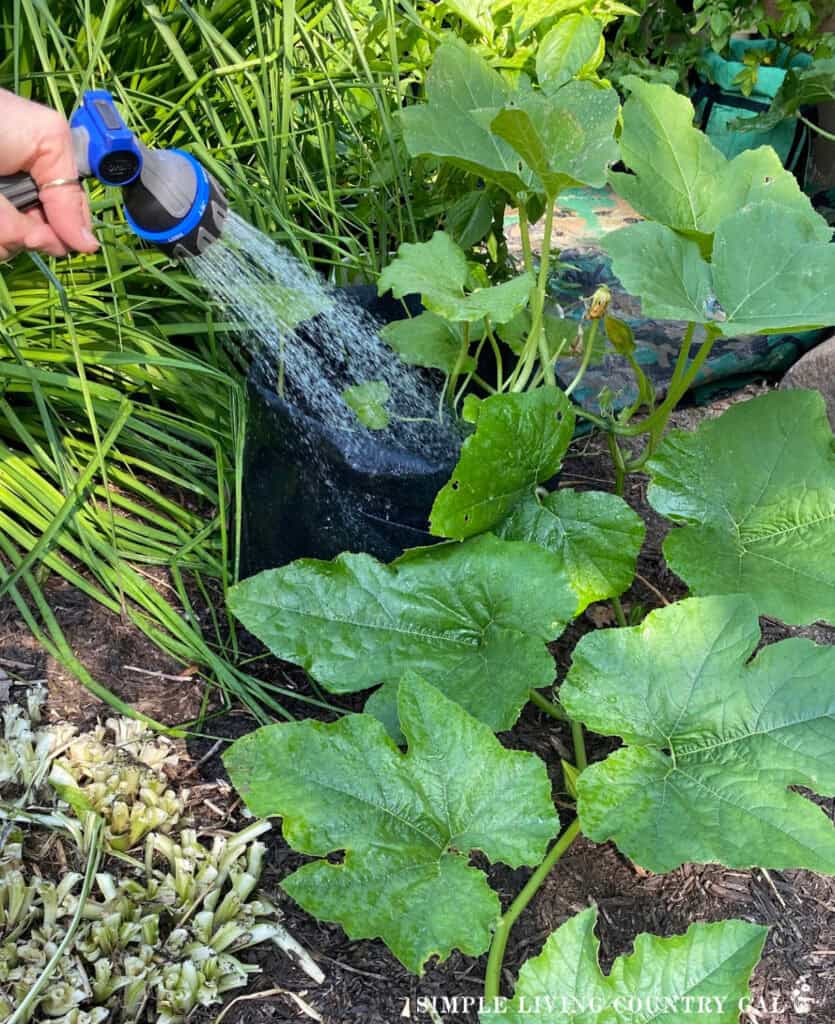
· Pumpkin vines are very delicate; be careful not to damage them or it could reduce the quality and quantity of the fruit.
· Pinch off the fuzzy ends of the vine after a few pumpkins have formed to stop the growth of the vine. This will direct the plant’s nutrients to the existing fruits.
· Pruning the vines may help with spacing as well as directing more nutrients to the fruits. Just do so with care.
· If you want to grow an especially large pumpkin, select 2 or 3 good candidates and remove the remaining fruits and vines to encourage all the nutrients to those fruits.
· Turn your pumpkins regularly, using care not to damage the vines. This will encourage a more even shape.
· Place heavy cardboard under the ripening fruit to avoid decay and insect damage on the underside.
More Garden Care Resources:
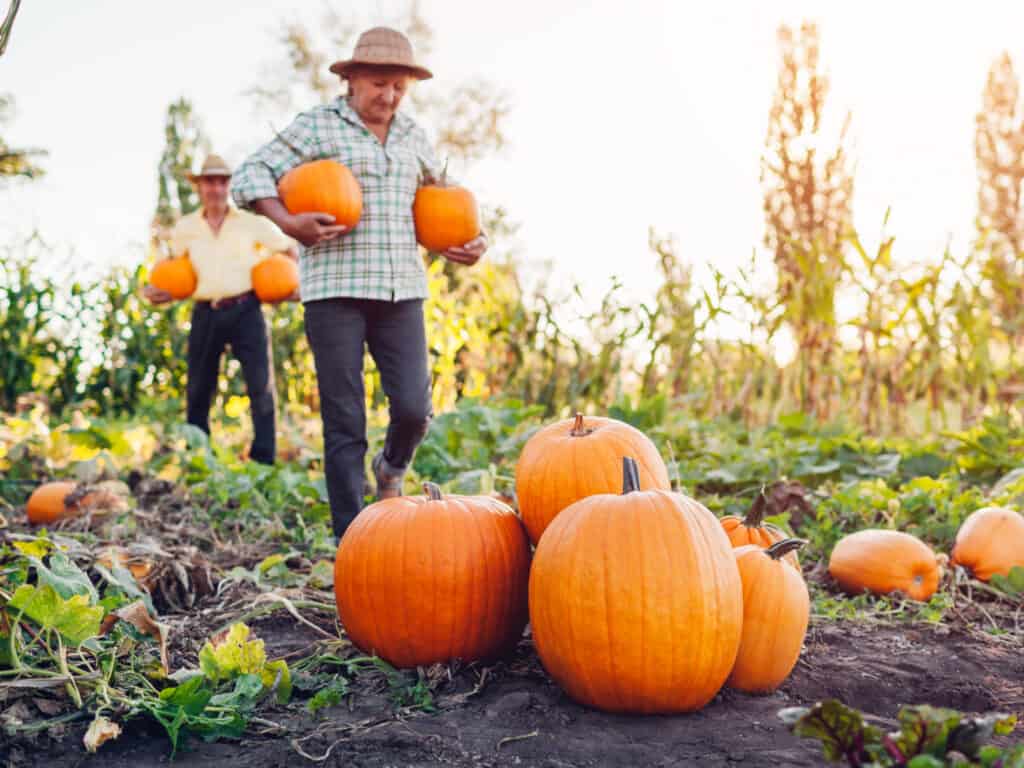
How to Harvest Pumpkins
It’s best to harvest pumpkins when they’re fully mature so that they’ll store longer. Don’t pick them when they’re small just because you want a smaller pumpkin. If that’s the case, you’re better off planting a small variety.
For most varieties, the pumpkin is ripe when the skin turns a deep, solid orange. The rind will feel hard when you thump on it and it will sound hollow. Try pressing your nail into the skin. If it resists puncture, it’s ripe.
Harvest on a dry day when the plants have died back. Cut the fruit off the vine carefully with a sharp knife or pruners, don’t tear. To slow the decay, leave a few inches of stem on the pumpkin; don’t cut too close to the skin. Pumpkins bruise easily, so be gentle with them.
How to Store Pumpkins
After harvesting, cure the pumpkins in the sun for about a week to toughen the skin. Then, move them to a cool, dry room for storage, somewhere around 55°. A cellar shed, or garage usually works well. Uncut and stored properly, you can expect the pumpkin to last 8 to 12 weeks.
Once carved (as in a jack-o-lantern) they’ll usually last 5 to 10 days.
If you’re saving the pumpkin seeds, they should last for about 6 years.
What Diseases and Pests to Watch For
There are a few pests and diseases to keep an eye out for including:
· Squash bugs – Squash bugs use their sharp mouthparts to suck out all the good stuff from the plant’s sap. This can cause some serious damage, leading to yellow and, eventually, brown spots on the plant. If left unchecked, squash bugs can even kill young plants and greatly reduce the yield of mature pumpkin plants.
· Cucumber beetles – Cucumber beetles will chomp away at leaves, flowers, and even the pumpkin itself. They will lay eggs on the underside of the leaves of the plant and if left to hatch can turn one beetle into dozens quickly.
· Aphids – Aphids, often known as plant lice, are small, sap-sucking insects that feed on the sap of the plant, weakening it by extracting essential nutrients.
· Squash vine borer – Squash vine borers are destructive pests that target members of the gourd family, especially pumpkins. These pests are moth larvae that burrow into the stems of pumpkin plants, impairing their ability to transport water and nutrients. The initial signs of an infestation include wilting leaves, despite adequate watering, and frass (sawdust-like excrement) near the base of the plant. If not managed promptly, squash vine borers can kill plants by obstructing the flow of essential resources through the stems.
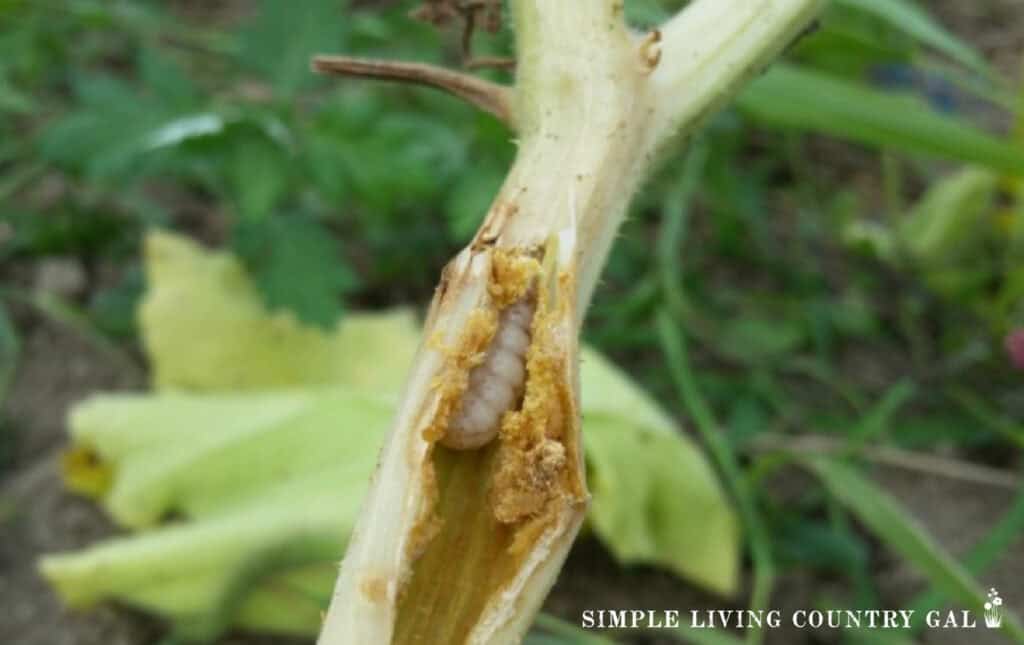
· Powdery mildew – Powdery mildew is a common fungal disease that affects a wide range of plants, including pumpkins. It is characterized by white, powdery spots on the leaves, stems, and sometimes the plant’s fruits. This fungus thrives in warm, dry climates with cool nights, so it often becomes a problem later in the growing season.
· Anthracnose – Anthracnose is a common plant disease that thrives in warm, wet environments, developing dark, sunken lesions on the fruit, leaves, and stems of pumpkin plants.
Not enough sunlight, too much fertilizer or water, and reduced pollination can also have a negative effect on your pumpkin growth.
Row covers and mulch will help to reduce both pests and weeds. Just remember to remove the row covers before the plants flower so they can be pollinated.
Be sure not to overwater or over-fertilize. And if you see signs of disease, remove the infected fruit and discard it.
Cooking With Pumpkins
Pumpkins are a staple of many fall desserts and bring with them a smell of the holidays. You can use pumpkins in butter, pies, or even cakes.
Growing pumpkins is fairly easy for beginners. They don’t take a lot of work or a lot of gardening knowledge. And they can be fun for the whole family. Just keep in mind that they do take a significant amount of time to grow, and they do need a lot of space for spreading out.
Other How to Grow Resources:
- How to Grow Sweet Potatoes for Beginners
- How to Grow Asparagus for Beginners
- How to Grow Chili Peppers for Beginners
How to Grow Pumpkins
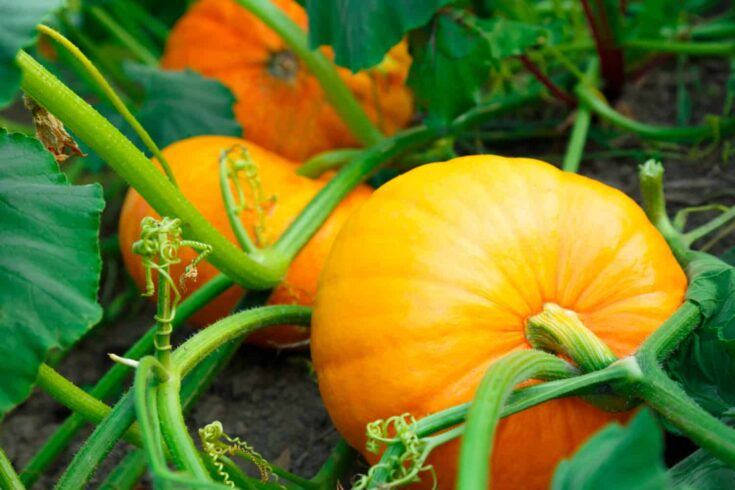
How to grow big orange pumpkins in your own backyard that are perfect for Halloween carving. Get planting tips and care so you are growing the biggest pumpkins this year. How to grow pumpkins step by step from planting to harvest.
Materials
- Pumpkins Seeds
- Water
- Manure
Tools
- Soil Thermometer
- Garden
- Rake
- Hoe
- Shovel
Instructions
- Prepare the soil with manure at a depth of 12-15 inches.
- Work into the ground with a rake or hoe.
- Create mounds in your growing area that are 4-8 feet apart.
- Plant 4-5 seeds per hill at a depth of 1 inch.
- Once you have 2-3 " tall seedlings, thin to 2-3 plants per hill.
- Water pumpkins evenly each week, keeping the soil moist but not soggy.
- Add manure or compost mixed with water routinely as needed.
- When plants are about a foot tall and before the vines begin to run, switch over to a high-phosphorus fertilizer.
- Add mulch around your plants to keep the soil moist, suppress weeds, and discourage pests.
- Pinch off the fuzzy ends of the vine after a few pumpkins have formed to stop the growth of the vine.
- For a more even shape, turn your pumpkins regularly, using care not to damage the vines.
- Harvest pumpkins when the skin is a deep orange, and the rind feels firm.
- After harvesting, cure the pumpkins in the sun for about a week to toughen the skin.
- Carve when ready and enjoy!
Notes
When growing pumpkins, remember:
- They take 3 months to grow. For a fall harvest plant between May and June.
- They need plenty of room for the vines to spread and grow.
- Be sure there is lots of sunshine throughout the day.
- Plant in an area where there is good drainage.
Recommended Products
As an Amazon Associate and member of other affiliate programs, I earn from qualifying purchases.
-
Survival Garden Seeds - Jack-O-Lantern Pumpkin Seed for Planting - Packet with Instructions to Plant and Grow Orange Carving Pumpkins in Your Home Vegetable Garden - Non-GMO Heirloom Variety
-
Pumpkin Juice 11-8-5 - Foliar Liquid Fertilizer with Essential Micro-nutrients for Pumpkins and Vegetables (1 Quart)
-
Urban Worm Soil Thermometer - 5-in Stanless Steel Stem - Perfect for Gardening & Worm Bin











